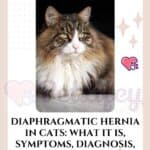Umbilical hernia in cats is a congenital disorder that sometimes has no symptoms. Let’s find out together how to intervene.

If our four-legged friend has a lump on the abdominal area, we could be facing a cat’s umbilical hernia. This is a problem that is not always easy to identify, also because the feline may not experience particular symptoms or pain to the touch. Here’s what you need to know about it and how to intervene on the problem.
What is that?
Among the various hernias that can affect the cat, the umbilical one is one of the most common; it is certainly the most frequent among those of the abdominal type.
It is a fairly common disorder of congenital origin; therefore it occurs from the moment of birth, and often appears simultaneously with other pathologies, such as, for example, chiptorchidism in cats.
As is known, the hernia consists in the spill, total or partial, of an entrails from the cavity in which it is normally contained.
What are the symptoms of umbilical hernia
Umbilical hernia is more common in dogs than cats; but it is still a disorder capable of afflicting the little feline.
The hernia appears to the eye as a lump that stands out in the abdominal part of the animal; more precisely, as the name suggests, near the navel.
It is not always easy to identify the presence of the hernia, and the reason is quite simple; it does not always cause pain to the animal, especially where it is small. In this case it would be difficult to notice the disorder even visually, and in the absence of particular symptoms that afflict the feline, very often the hernia is not identified.
As a rule, the larger the size of the hernia, the more pain the feline feels.
Therapeutic treatment

In the event that the cat feels pain in the abdominal area, and a swelling is visible or palpable in it , it is good to immediately alert our trusted veterinarian, who will be able to notice the problem starting from a superficial visit.
The practitioner usually arranges additional tests such as x-rays, which can sometimes be assisted by an ultrasound.
The prescribed therapy is surgical, aimed at removing the hernia with a specific intervention. Often, if the hernia is diagnosed during the first check-ups, the operation can be combined with that of sterilizing the cat , both requiring the use of anesthesia.
Surgical removal of the hernia is not always necessary; in particular, if small in size, it may not cause any disturbance to the little feline. Therefore, especially if the discovery of the problem occurs when the animal is already an adult, it may be appropriate not to intervene.






